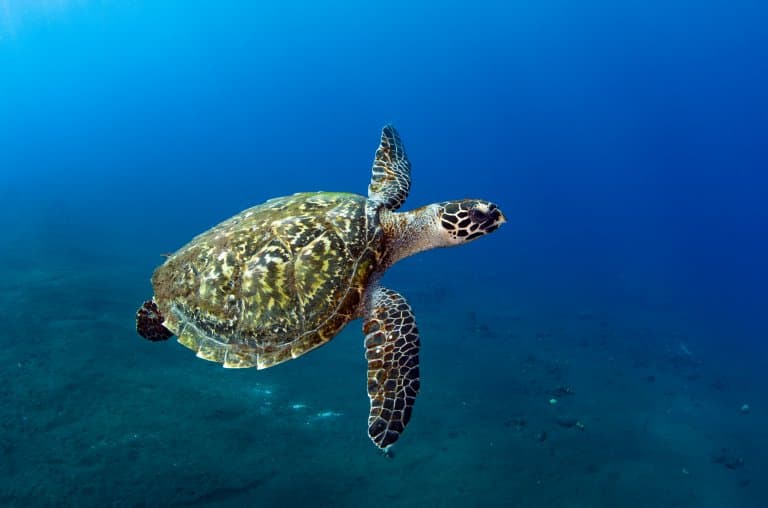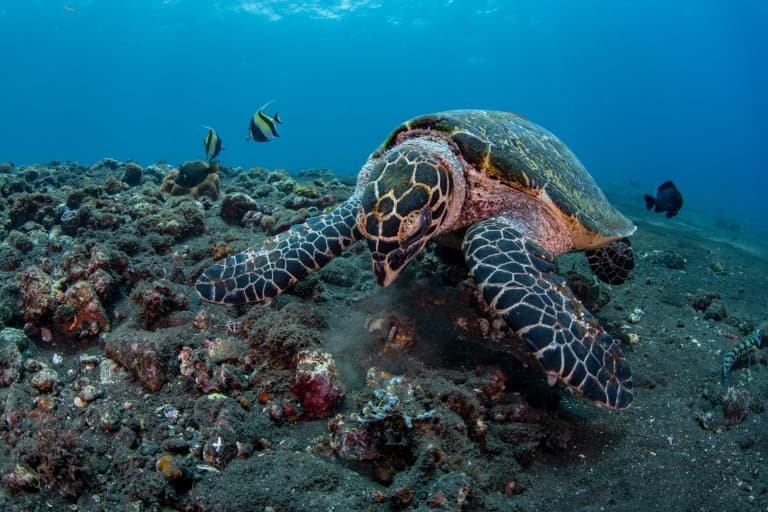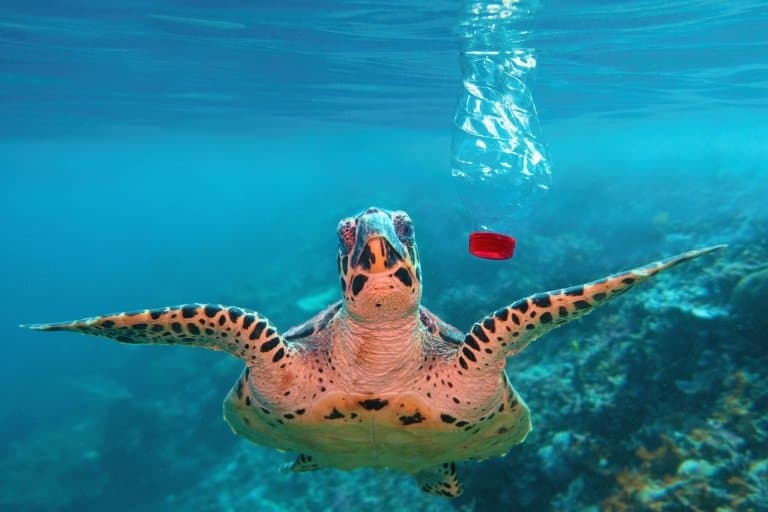Hawksbill Sea Turtle Profile
It’s rare that you can be justifiably envious of a wild animal’s habitat, but if there’s one place that would be more comfortable than an Ikea bedroom it has to be the reef. At least, if you could live there without drowning, or being constantly in fear of being eaten.
Hawksbill sea turtles would have it just right if we could just stop killing them.
The hawksbill turtle is a critically endangered sea turtle, that spends much of its time in shallow lagoons and coral reefs in tropical waters of the the Indian, Pacific, and Atlantic Oceans.

Hawksbill Sea Turtle Facts Overview
| Habitat: | Tropical Reefs, shallows, some temperate waters |
| Location: | Indian, Pacific and Atlantic Oceans |
| Lifespan: | Possibly upwards of 50 years |
| Size: | 1.2m (4ft) |
| Weight: | Average around 80kg (175lb) |
| Colour: | Yellow/cream belly with grey, gree, brown or dappled shell |
| Diet: | Algae, soft corals, sponges |
| Predators: | Birds, crabs, sharks, mammals |
| Top Speed: | Unknown, cruising speed of around 3.2km/h (2mph) |
| No. of Species: | 1 |
| Conservation Status: | Critically Endangered (IUCN) |
Hawksbill sea turtles have an amber shell with light and dark streaks, elongated heads and beak-like mouths, and typically grow up to 1m (3ft) in length and weigh approx. 80kg.
They spend most of their lives in tropical coral reefs, resting in caves and on ledges. Unlike their close relative the green sea turtle who are mostly herbivorous, they are omnivorous and diet mainly on sea sponges, as well as algae, plants, jellyfish, mollusks, crustaceans and fish.
Sadly, they are in big trouble, especially in Southeast Asia.
These turtles are really important for healthy oceans; they help keep coral reefs in check and are a part of the food chain. It takes them a long time, like 20 to 40 years, to grow up and have babies.
They’re in danger for a bunch of reasons: people want their unique shells, their eggs get stolen, and human activities like fishing and building are wrecking their habitats.
Some efforts to help them are working, especially in the Caribbean, but fighting the shifting baselines of human perspective in each generation is a big challenge.
Interesting Hawksbill Sea Turtle Facts
1. Heart-shaped babies
The lifecycle of the Hawksbill begins as an egg, laid on a beach, much like other species of sea turtle.
A female clears a space and digs a hole, into which she plops a clutch of round eggs. These are then covered, and the young will mature on their own.
Two months later, a miniature turtle emerges from the sand 4cm long and weighing less than 20g. Their carapaces resemble little hearts, but despite being painfully cute, almost every predator around is now on the hunt to collect them.
From this point onwards, it’s a hard existence for the turtle. They must instinctively crawl towards the sea using the reflection of the moon on the water as a guide before they are preyed upon by birds, crabs and most things bigger than them. 1
2. They are biofluorescent
It’s unknown as to why they are biofluorescent, but they are the first reptile to be recorded with this characteristic.
It’s speculated this might be due to their diet, but it’s also believed to be more intense in color in males than females, which may suggest a behavioural role.
3. Hawksbill sea turtles are capable of feeding on dangerous jellyfish
Hawksbill sea turtles will close their eyes, use their sharp claws on their flippers and beak to attack and eat venonmous jellies, hydrozoan and the Portuguese man o’ war.
Their tough skin and armoured heads can’t be penetrated by the stinging cells of the Portuguese man o’ war.
Due to eating venomous cnidarians as well as toxic sponges, hawksbill sea turtle meat itself can become toxic and dangerous to other animals, including humans. For this reason, they made our ‘The Most Poisonous Animals in The World‘ list.
4. They live solitary lives
Hawksbill sea turtles are solitary for most of their lives, and they only meet to mate.
This is similar to other sea turtles, who also live solitary lives. They are highly migratory and will migrate to breeding grounds biannually to mate in secluded lagoons.
5. They’re important to the reef
Hawksbill sea turtles play a crucial role in marine and coastal ecosystems by contributing to food webs and transporting nutrients.
They are particularly important for maintaining healthy coral reef systems. While they primarily consume sponges in the Caribbean, their diet is more varied in other regions such as the Indo-Pacific.
For example, in northern Australia, they eat significant amounts of algae, and in the Great Barrier Reef, they consume soft corals.
Their foraging habits depend on the specific habitat they are in, and where they primarily eat sponges, Hawksbills help sustain the health of coral reefs by controlling sponge populations, which, if left unchecked, could out-compete reef-building corals for space.

6. They might change colour!
There’s a commonly repeated factoid going around that this turtle’s shell changes colour in response to temperature fluctuations.
This may or may not be true, but it’s hard to find a reputable source to back it up, and these claims are uncited.
The closest thing to evidence is the report published in Amphibia-Reptilia journal, that the hawksbill carapace goes through stages of development and colouration on a yearly cycle, with black speckles forming during the cooler dry season, and the amber colouration forming in the warmer part of the year.
However, these colour changes might have more to do with the development of the carapace in juveniles, and it’s unclear whether this phenomenon is present in adults. 2

7. This colouration has made them a popular target
Tortoiseshell was once a common decorative item throughout the world, and, much like ivory, it has a murky history of status and destruction.
Derived from the Hawksbill turtle, this material has been a highly prized material for centuries. Used in various goods from jewellery to combs, its trade has spanned across ancient empires in Egypt and China, the East Indies, and eventually globalized through European conquest.
Hawksbill populations have been critically affected due to overexploitation. The trade was particularly rampant in the 20th century, with Japan being the largest importer of tortoiseshell. Statistics reveal millions of Hawksbills were killed for this trade during this period.
In an effort to protect the species, the Hawksbill was included in the CITES treaty in 1975, with varying levels of compliance and loopholes exploited by countries. Though international trade largely ceased by the end of 1992, the Hawksbill turtle remains endangered, and the industry still exists based on stockpiled material.
8. They are critically endangered
Globally, Hawksbill populations continue to decline, especially in Southeast Asia, and remain critically endangered due to ongoing exploitation and long-term declines.
Some conservation efforts have led to population stabilization and even growth, most notably in the Caribbean, but these are exceptions rather than the norm, and the global numbers are decreasing.
Still, the species is well overdue for a re-assessment. Unfortunately, the outcome of this is unlikely to be better, as the conditions affecting the species have hardly changed and in many cases have gotten worse. 3
9. Human fishing is primarily responsible
Hawksbills mature over 20 to 40 years, making them very slow to reproduce. This means that the death of an individual takes decades to replace.
Hawksbill turtles face multiple threats that severely impact their population and survival.
The tortoiseshell trade has historically been the most damaging, killing millions of Hawksbills, especially females, for markets in Europe, the U.S., and Asia. Illegal egg collection remains a significant issue, particularly in Southeast Asia.
The turtles are also hunted for their meat, sometimes to be used as shark bait. Rapid coastal development for tourism destroys their nesting habitats, while industrial activities like oil refineries further exacerbate the problem.
Hawksbills are closely tied to coral reefs, which are endangered ecosystems themselves, particularly due to climate change-related coral bleaching and damage from trawler nets.
But one of the most commonly ignored threats to hawksbill turtles is the fishing industry. Hawksbills are particularly susceptible to entanglement in gillnets and accidental capture on fishing hooks.
Bycatch is a serious threat to hawksbill turtles, as it is to many other species. As fish stocks are reducing globally, fishing activity is increasing to compensate, and more nets mean more bycatch.
And with ongoing cases of species decline, there is the ever-constant battle with human perceptions and attitudes. 4

10. Their lifespan is unknown
While it’s thought that Hawksbill sea turtles reach maturity over 20-40 years, actually much of their life is unknown, including their true lifespan.
However, turtles are typically long-lived, and its thought that their lifespan could be over 50 years.
11. Shifting baselines
Only 20 years ago, the evening skies of Northern Europe were commonly blackened with the magnificent murmuration of the common starlings.
In the UK, their decline began in the ‘80s and for people growing up there today, such a sight is entirely unknown to them. The perception of starling populations has shifted its baseline.
The same is true for sea turtles.
The decline of hawksbill turtle populations in the Caribbean is evident from the records, with places like Chiriquí Beach in Panama once being major regional rookeries.
While some have inferred from the current scarcity of hawksbills that they are naturally rare, this perception is more likely due to the same “shifting baseline” phenomenon.
This essentially means that each new human generation perceives the environmental conditions they first encounter as the norm, thereby constantly resetting baselines and losing historical perspective.
In the case of hawksbills, the incorrect perception of their natural rarity is likely a consequence of their numbers already being severely depleted before comprehensive assessments began, and as with all conservation efforts, it’s important to educate people on the historical condition of the species in order for them to understand the trends.
We are losing species at an alarming rate, and forming accurate perspectives on this is the key to species recovery programs.
Hawksbill Sea Turtle Fact-File Summary
Scientific Classification
| Kingdom: | Animalia |
| Phylum: | Chordata |
| Class: | Reptilia |
| Order: | Testudines |
| Family: | Cheloniidae |
| Subfamily: | Cheloniinae |
| Genus: | Eretmochelys |
| Species: | Eretmochelys Imbricata |
Fact Sources & References
- (2018), “Over 100 endangered turtles hatch in Singapore”, PhysOrg.
- Mari Kobayashi (2001), “Annual cycle of the speckle pattern on the carapace of immature hawksbill turtles (Eretmochelys imbricata) in Cuba”, Brill.
- “Hawksbill Turtle”, IUCN Red List.
- “HELP SAVE RHINOS”, World Wild Life.
